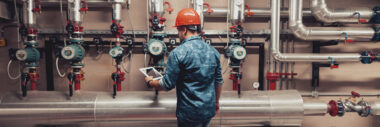When designing fuel trains for a boiler, furnace or oven, one of the key parameters you should strive to maximize is flow. Poor flow in a fuel train can limit the burner’s performance and can also put your entire combustion system at risk of shutting down in the event of low fuel pressure. Fortunately, selecting the right fuel train components can overcome these issues without breaking the bank. Here are a few strategies to consider when maximizing a fuel train system’s performance:

Low fuel pressure can also cause your entire combustion system to shut down if there is poor flow in the fuel train. Maximizing the performance of a fuel train system can be accomplished in three ways. Learn more in this whitepaper.
Focus on High-Impact Components
In a typical system, up to 70 percent of pressure drops are caused by the two safety shutoff valves. If the goal is to maximize fuel train flow, it’s imperative to select a shutoff valve with the highest flow coefficient (Cv or Kv) rating for the given pipe size. Newer safety shutoff valves have been optimized for flow and in some cases, a fuel train can be designed one or two sizes smaller while maintaining performance, reducing the overall cost of the system.
Reduce Component Number
A typical fuel train contains the following components: a regulator, two safety shutoff valves, pressure switches and a flow control valve. The current trend in the combustion industry is to combine these components into a single valve body — typically called a monoblock or double-body valve. This design accomplishes a few things: it improves the flow of the overall system, reduces the footprint of the overall fuel train and reduces installation and maintenance time.
Preventative Maintenance
Regular maintenance is critical to ensure optimal fuel train performance. Some safety shutoff valves come with an integrated strainer, which protects downstream devices from contaminants in the fuel line. When performing maintenance checks, be sure to clean the strainer and ensure it’s not a source of flow blockage.
Combining these practices when designing gas train systems will ensure optimal performance while improving reliability, reducing costs and boosting energy efficiency. To learn more, please visit: www.emerson.com/combustion or download the Gas Train Performance whitepaper.




